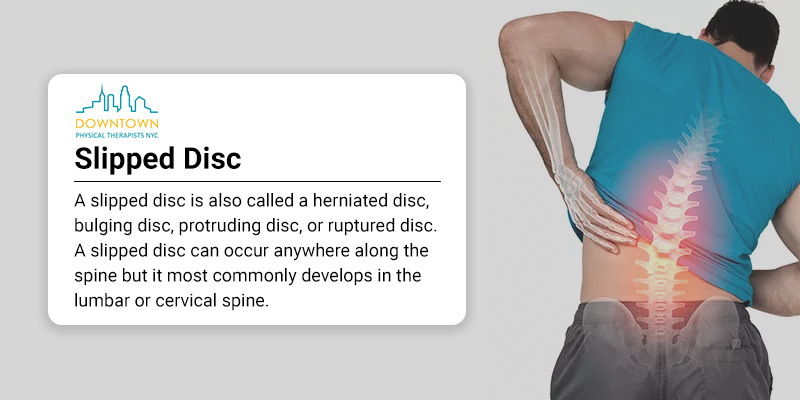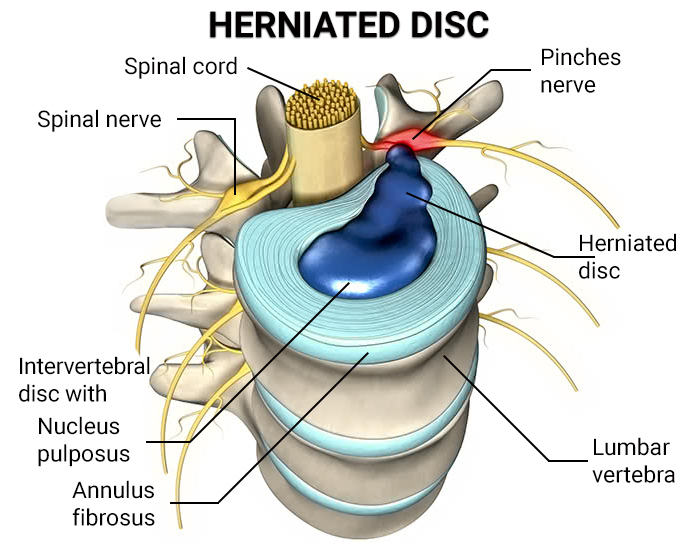Slipped disc pain can make your life miserable and even the most basic tasks can become difficult and tedious. It is best to deal with the telltale signs of a herniated disc before the symptoms worsen and lead to reduced mobility or other complications. Fortunately, a wide variety of effective pain management techniques are available that help to get your pain in control and give you a chance to resume normal life activities. The award-winning physicians and therapists at the Physical Therapists NYC offer comprehensive and personalized recovery plans that focus on your specific level of pain. Using state-of-the-art facilities and cutting-edge techniques that focus on progressive care, highly trained and experienced therapists work hard to alleviate your discomfort without surgical intervention.
The spinal column is made up of a series of bones or vertebrae stacked onto each other. From top to bottom, these bones are cushioned by discs. These discs act like shock absorbers and protect the bones from damage during daily activities such as walking, lifting, and twisting. Spinal discs are perhaps the most important structures in the spine. Strong, flexible discs allow the spine to move freely and fluidly as we lift, bend or twist.
Natural wear and tear due to aging and weight lifting can make the spinal discs become stiff less flexible which leaves them unable to provide the required support and cushioning to the bones. Disc degeneration makes the discs are vulnerable to damage and injury. A slipped disc in the back of the neck is a common experience problem.

What Is a Slipped Disc?
A slipped disc is also called a herniated disc, bulging disc, protruding disc, or ruptured disc. Disc herniation occurs when degenerative changes make the tough, fibrous outer shell of a disc to break or tear that releases its inner fluids into the spinal canal. A slipped disc can occur anywhere along the spine but it most commonly develops in the lumbar or cervical spine.
A lot of people experience disc herniation without any pain or symptoms but for most people, a slipped disc can cause considerable pain, weakness, and difficulty walking or standing. In some cases, slipped disc symptoms were similar to other back and spinal conditions.
Here Are 3 Signs That May Indicate Your Pain Is Coming From a Slipped Disc.
Pain, Numbness, or Weakness in Arm or Leg
Back or neck pain are believed to be the primary symptoms of a herniated disc. While it is true that a slipped disc in the lumbar or cervical spine causes low neck or back pain, common signs of a herniated disc also include pain, numbness and weakness that extends to the arms or legs.
Sciatica is one of the most common symptoms of slipped disc in the back. When the inner material from damaged disc leaks out into the spinal canal, it irritates or compresses the nearby nerves. When the disc fluid compressions the sciatic nerve, it can result in one-sided pain, weakness, numbness and tingling sensations that travel from the low back to the buttocks, thighs and calves. Some people experience sciatica like a constant deep ache or a sharp burning pain that strikes suddenly.
A slipped disc in the neck can also pinch or irritate nearby spinal nerves. Nerve compression in the cervical spine can lead to one-sided pain, weakness, numbness and tingling that begins in the necks and travel down to shoulder, arm and hand. The type of pain also varies from person to person. It is important to consult your doctor if numbness and tingling affects your ability to control your muscle movement.
Pain During Certain Movements
If you have a herniated disc, you may feel the pain strike suddenly or even worsen when you make certain movements such as sitting from standing, standing from sitting or bending. Pain that comes on suddenly with any type of activities is sharp, stabbing or electric.
Movements or body positions that trigger pain include:
- Coughing or sneezing
- Prolonged sitting, standing or walking
- Hunching forward or turning
Slipped disc pain strikes or aggravates with these activities as they place more pressure and stress on the spine and spinal nerves.
Pain Subsides With Rest
Another sign of slipped disc is that you may feel the pain subsiding with rest. You will find relief from pain when you lie flat on your back with bent, supported knee or sit in a reclining chair as it relieves the downward pressure on the spine.
You may be suffering from herniated disk without feeling any symptoms. You might not know you have it unless you visit your doctor or therapist and have it diagnosed with imaging tools.

What Causes Slipped Disc?
Each disc has two parts. There is a soft, gelatinous inner part and a tough outer ring. A slipped disc occurs when the outer ring becomes weak or tears as a result of injury which allows the inner portion of the disc to bulge out. This is known as a slipped or prolapsed disc and results in pain and discomfort. If the slipped disc begins to compress any of the spinal nerves, you may also experience numbness and pain along the affected nerve. In severe cases of slipped disc, surgery may be needed to repair the slipped disc.
Some common causes of a slipped disc include:
- Certain movements or activities
- Aging
- Unnatural turn or twists
- Lifting very large, heavy objects that places great strain on the lower back
- Obesity or being overweight as the discs are unable to support additional weight
- Weak muscles
- A sedentary lifestyle
You are more likely to experience a slipped disc as you grow old as the discs begin to lose their protective wear and tear as you age. As a result, they can slip out of place easily. Slip discs are more common in men than women.
How Slipped Disc Is Diagnosed?
If you experience recurring pain in the back, consult your primary care doctor or a physical therapist who will take your medical history to understand your symptoms and the type of pain you are having. They will ask you about injuries or medical conditions you suffer from, even prior to the pain to determine if any lifestyle habits are causing the discomfort. The doctor will also examine you physically to check for source of pain and test for any muscle weakness or numbness.
The doctor may ask for the following tests to diagnose your slipped disc:
- X-ray
- CT scan
- MRI scan
- EMG
- Myelogram
These tests provide a detailed view of the spine and detect the extent of damage and nerve compression. Based on the results, you may be referred to a specialist or a physical therapist who will recommend the best-suited treatments for your back pain and symptoms.
Treatment Options for Slipped Disc
Treatment for slipped disc ranges from conservative to surgical, depending on the level of pain and discomfort you are experiencing and how far the disc has slipped out of place. You can seek relief from pain by taking over the counter medications, avoiding lifting heavy objects and focusing on exercises that strength your back and neck muscles.
It is essential to seek medical advice and visit a physical therapist if you are experiencing any of the symptoms. Most cases of slipped discs heal naturally with 6 weeks without requiring nay surgery. Your therapist may come up with a personalized treatment plan to ensure you make a full and speedy recovery and get back to normal routine in shortest possible time.
The following treatment options work best for a slipped disc:
Rest
Doctors recommend avoiding high impact activities that can flare up the pain. However, they also advice against resting too much as long term immobilization can leave you with even more pain, stiffness and inflammation. Staying active with low impact activities, such as yoga or swimming that do not cause pain or discomfort, will help you recover in a much better way.
Hot and cold packs
Applying hot and cold packs several times a day to the affected part of the neck or spine can help to soothe the pain and relieve swelling, inflammation and stiffness. Alternate between ice and heat packs and you will feel better.
Medications
Over-the-counter pain medications like acetaminophen or ibuprofen are effective for dealing with mild to moderate slipped disc pain. If your pain continues to increase or you are unable to tolerate the intense pain seek medical attention. The doctor may prescribe a stronger pain reliever, muscle relaxant or nerve pain medication to help you feel better.
Cortisone injection
A cortisone injection can provide temporary relief from inflammation and irritation around the compressed nerves in the spine. Even though the effects of this injection are short term, it provides your body a chance to start the healing process and you can find some much-needed break from the persistent pain and discomfort.
Physical therapy
Physical therapy can work wonders for your slipped disc and play a significant role in strengthening your back and surrounding muscles and joints. Experienced therapists recommend the best stretching exercises that relieve pressure on the spine and reduce pain. The award-winning therapists at the Physical Therapists NYC are dedicated to delivering the best care possible. They focus on the type of pain you are facing, discover your needs and create a personalized treatment plan to ensure a speedy recovery.
Surgery – the last resort
For slipped discs that continue to cause significant pain and associated symptoms even after 6 weeks or a shift far out of place, surgery may be the last option to get them back in place. The doctor will perform a minimally invasive spine procedure to remove part or all of a damaged disc and decompress pinched nerves. Minimally invasive surgeries require smaller incisions, cause less muscle and tissue damage and heal swiftly as compared to traditional spine surgeries.
You can look forward to getting back to normal activities within a few weeks after the surgery as these surgeries are performed as outpatient procedures. Physical therapy is also important for post-operative rehabilitation. It helps you recover from the surgical procedure, regain mobility and recover faster, and ensures that any replacements or repairs made during surgery heal properly.
If slipped disc is causing considerable pain, has reduced your mobility and affected your quality of life, schedule an appointment with the top rated therapists to learn about the best approach and treatment plan for recovery. The award winning therapist and physicians at the Physical Therapists NYC have the best solutions to treat a range of spine and joint conditions. They offer exceptional care, pain management strategies and physiotherapy to treat lower back, spinal and muscular pain. The top-rated pain specialists not only help you seek relief from a slipped disc and related issues but also create a back physical therapy approach to help you avoid injuries and pain in future.





